New Year’s Eve in Spain: Guide to Celebrating in 2023!
Considering celebrating New Year’s Eve in Spain? Here’s everything to know before you book your flights!
New Year’s Eve is a huge event in Spain with many different celebrations taking place across the country on the night of December 31st. No matter where you choose to ring in the new year, you’re sure to experience an unforgettable evening with fun Spanish superstitions.
How do I know? I’m a former Spanish teacher who used to live in Spain! And, I’ve had the pleasure of ringing in the New Year in Spain on multiple occasions.
In this post, we’ll go over all the info about how New Years Eve is celebrated in Spain—from Spanish New Year’s Eve traditions to where to spend New Year’s Eve, practical tips, and what to expect.
8 New Year’s Eve Traditions in Spain
When it comes to how New Year’s Eve is celebrated in Spain, there are a number of fun Spanish traditions for New Year’s Eve to take part in. Here are eight you can’t miss:
1. Twelve Grapes at Midnight
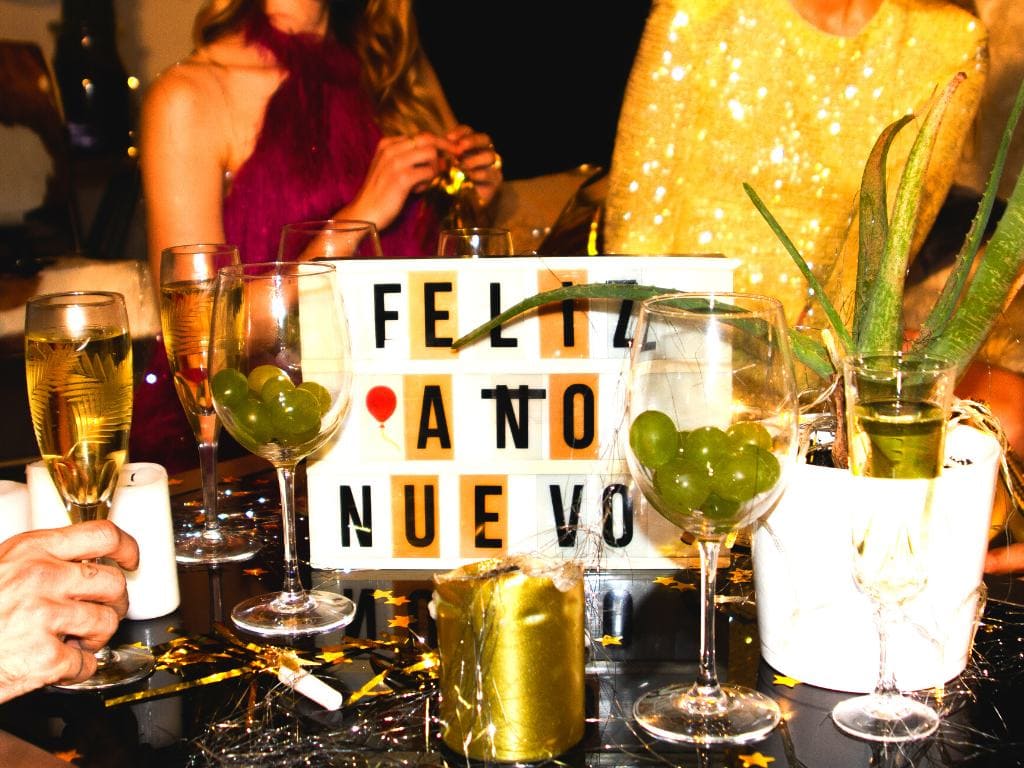
One of the most anticipated New Year’s Eve traditions in Spain is to eat 12 “lucky grapes” at midnight.
As the clock strikes midnight on New Year’s Eve (Nochevieja in Spanish), Spaniards eat twelve green grapes. But, they don’t just eat them all at once. Instead, it’s customary to eat the grapes one by one, one for each chime of the clock.
In Spanish, the grapes are called “las doce uvas de la suerte” (the twelve grapes of luck in English) The grapes are named so since they are said to bring good luck and prosperity for the coming year. In fact, each grape represents one month of the year.
It can be a challenge to swallow all twelve grapes in time, but it’s a fun and hilarious way to ring in the new year! Not sure when to eat them? Just follow those around you.
The beloved tradition of eating grapes at 12 am started in Madrid in 1909 when some Alicantese vine growers needed to sell off excess grapes from that year’s harvest. Since then, the tradition has spread. Families throughout the country gather around the television set to eat grapes along with the chimes from the Puerta del Sol in Madrid.
So, how can you participate? First, decide where you want to celebrate. Many cities and towns will have free events organized in their public squares. Then, buy your grapes—a few days in advance if you can. Wash and de-seed them so you end up with 12 clean, loose grapes! Store the grapes in a plastic baggy, and bring them with you to eat at midnight!
2. Toast With Cava & Gold
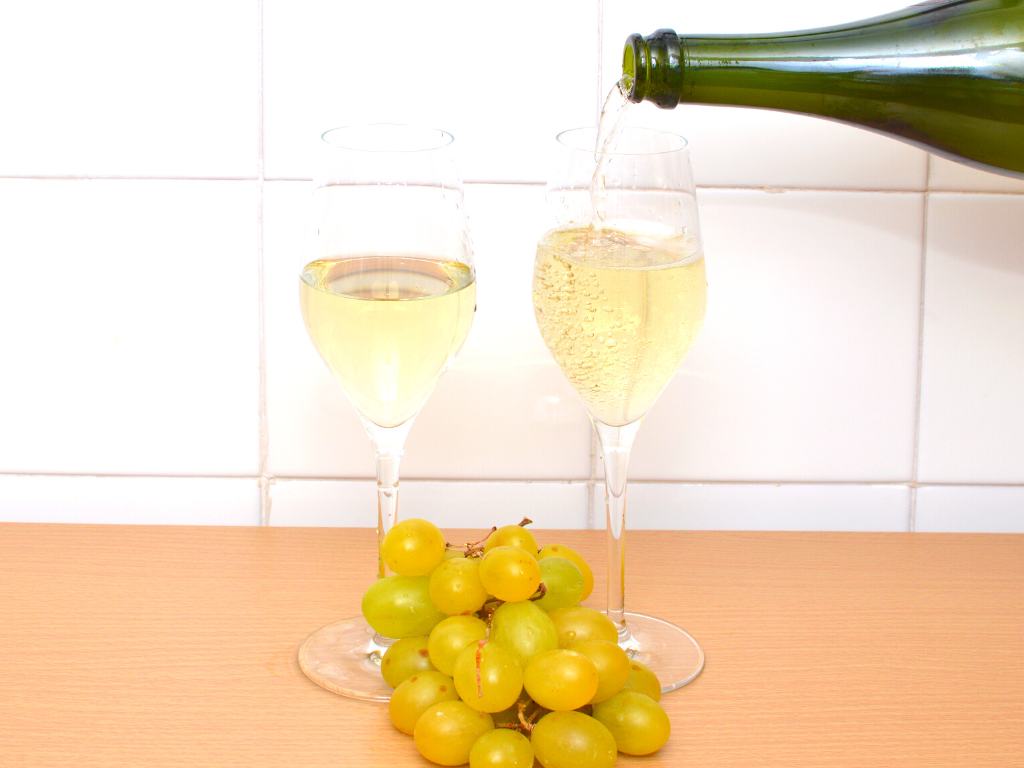
Cava is a sparkling wine that is popular in Spain, especially on New Year’s Eve. It’s often served with the twelve grapes and is a festive way to celebrate the occasion.
For a monetary fortune in the new year, some Spaniards drop a gold ring or coins into their cava! After you toast your friends in Spanish, glug down the entire glass to retrieve your gold object—otherwise, the charm won’t work!
Cava is made using the same method as champagne, but it’s produced in the Catalonia region of Spain. Wine, spirits, or mocktails work, too!
3. Red Underwear

Wearing red underwear on New Year’s Eve is said to bring good luck in love and romance for the coming year.
The origins of this Spanish tradition come from the Middle Ages when red, the color of passion and prosperity, was prohibited by the Church. Thus, red had to be hidden in intimate garments!
If you want Cupid to find you in the New Year, you’ll have to play by the rules. In some regions, this means you must give away your underwear or burn it by the end of the night!
Although this tradition sounds a little strange, the idea of taking off the old and putting on the new symbolizes closing a chapter and ushering in new and exciting things in the new year.
Many stores in Spain sell red underwear in the run-up to New Year’s Eve. Make sure to get a new pair to participate in this New Year’s Eve in Spain crazy tradition!
4. First Step With the Right Foot
As the clock strikes midnight, it’s traditional to take your first step of the new year with your right foot. This is said to bring good luck in the coming year as you start off the year “on the right foot.” (Pun intended.)
Depending on who you ask, your first step could mean a lot of things. Some believe it’s the very first step after the clock strikes 12, meaning you should suspend your right foot until the chimes stop. Others say it’s the first step entering or leaving your house for the first time after midnight.
We think you should do all three, just to be safe!
5. Churros with Chocolate at Dawn

Another favorite of the New Year in Spain traditions is to each yummy snacks!
After the midnight celebrations wind down, it’s very common to enjoy churros with hot chocolate before returning home at dawn the morning of January 1st.
This sweet and delicious treat is a popular way to continue the festivities and start the new year off on a sweet note. Regions like Castilla y León, Madrid, and La Mancha are most known for this tradition.
6. Lentil Soup on January 1st
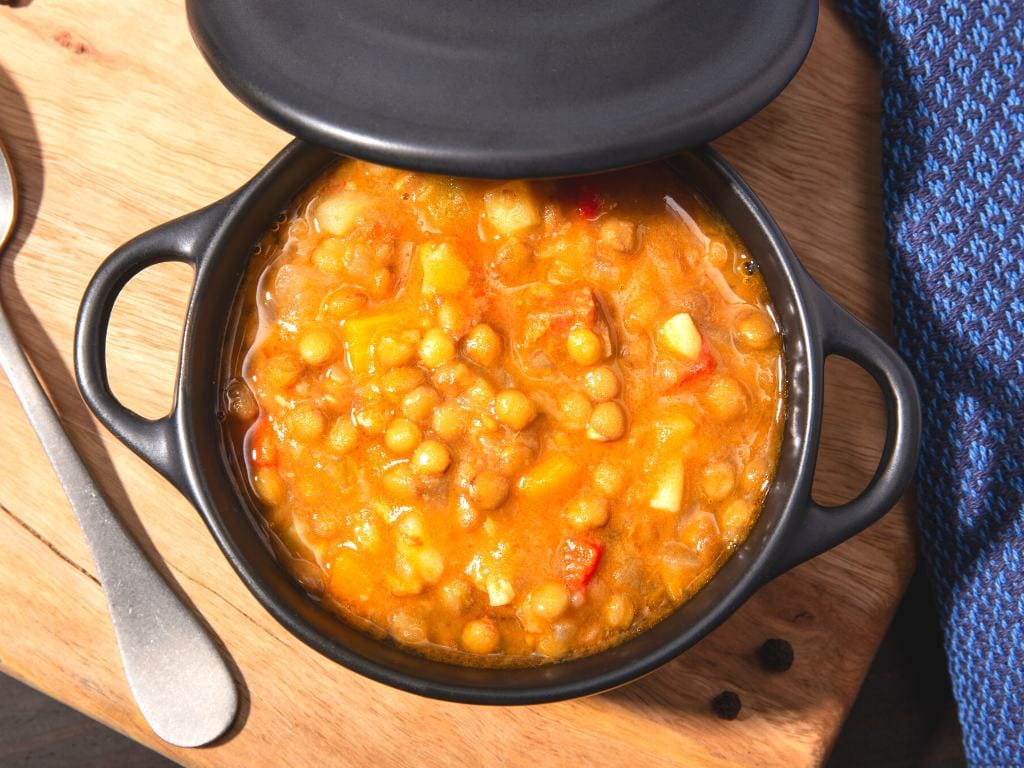
Eating lentil soup on New Year’s Day is another famous Spanish New Year’s custom.
Tradition says each lentil represents a coin that brings a prosperous new year. This custom, also celebrated in Italy comes from Ancient Rome. In those days, a gift of a bag of lentils for Notte di Capodanno (New Years Eve) was given with hopes they’d turn into gold.
This hearty and delicious soup is a popular way to start the new year off on a positive note.
7. Kisses for Everyone
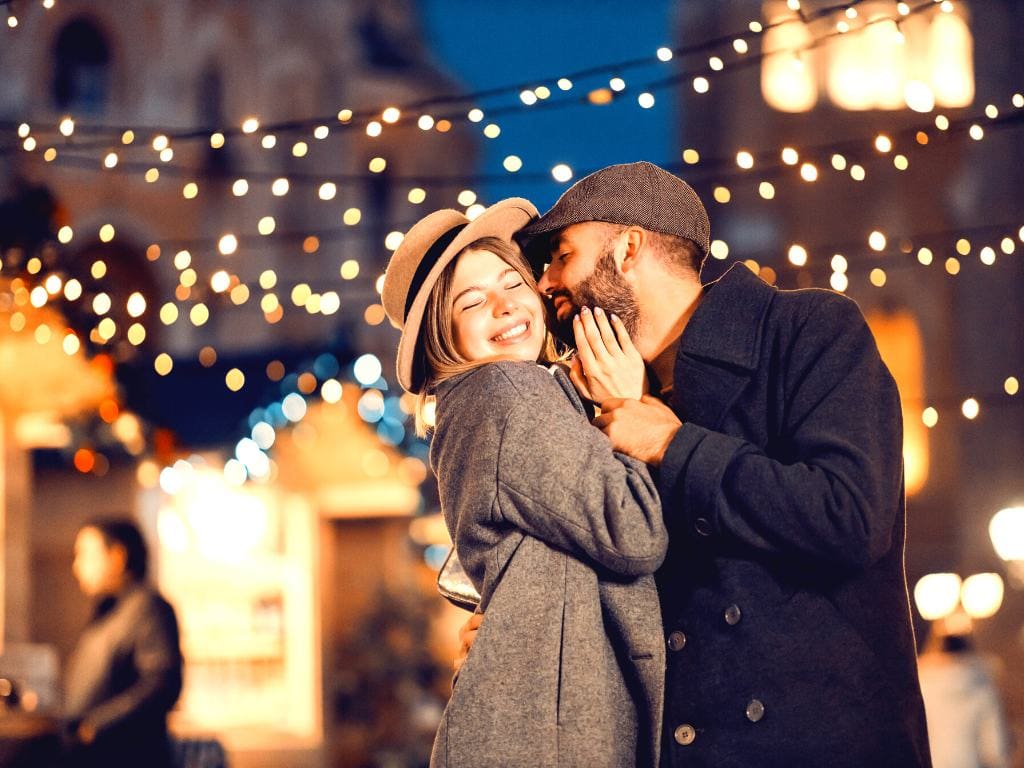
As you probably know, it’s customary for Spanish people to greet each other by giving two kisses, one on each cheek. Thus, one of the more obvious New Year in Spain facts is kissing!
To explain, after the clock strikes twelve and grapes are eaten, it’s common to give congratulatory kisses to family and friends.
8. New Year’s Eve Dinner
Prior to gathering to watch the clock strike twelve on TV or in person, Spaniards bid the year adieu with a large family dinner.
This large feast may vary by region and individual preferences, but it’s not uncommn to see suckling pig, turkey, or roast lamb are a classic. Traditional desserts of the season include polvorones (shortbread cookie) and turrón Spanish nougat.
5 Best Places in Spain for New Year’s Eve
Spain is known for its festive and sparkly New Year’s Eve celebrations. Here are some of the best places to celebrate the arrival of the new year in Spain:
1. Madrid’s Puerta del Sol Celebration
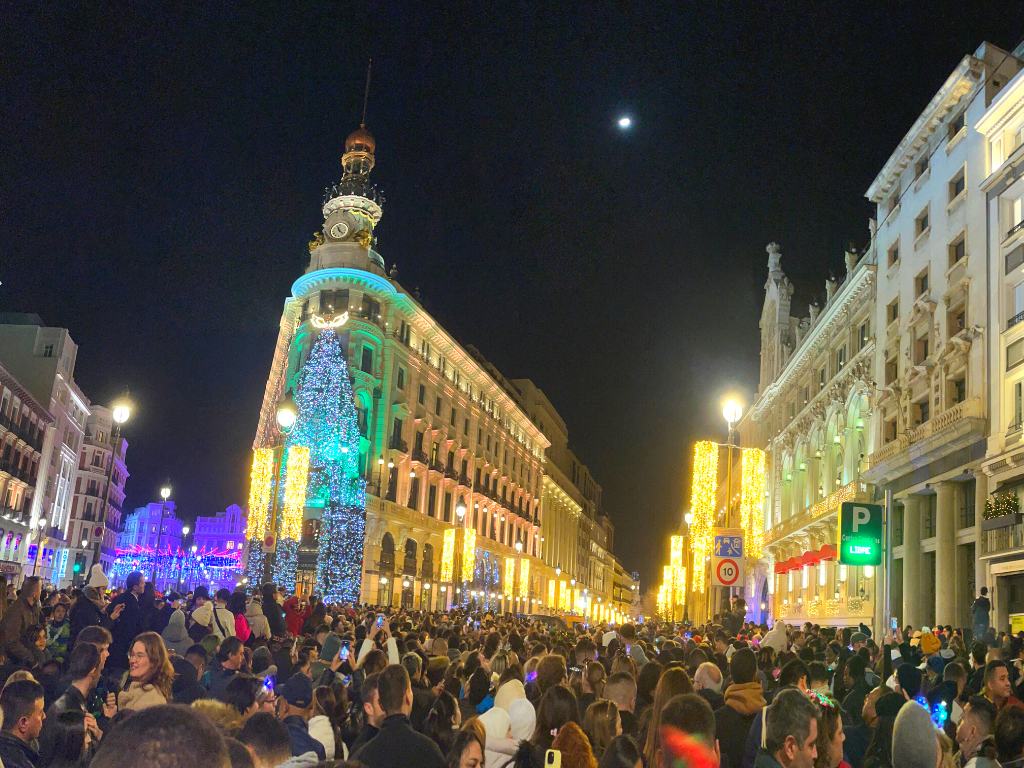
The most famous place to celebrate New Year’s Eve in Spain is Madrid’s Puerta del Sol. It’s from here that the New Year’s bells, Las Campanadas, are broadcast around the country.
If you’d like to attend, get there early: upwards of 25,000 people gather in this central square to count down to midnight, grapes in hand!
The atmosphere is festive and lively with revelers dressed in silly hats, wigs, and glasses for purchase in tourist shops nearby. After the bells ring and grapes are eaten, locals and tourists alike pop bottles of cava, toasting and wishing each other a “Feliz Año Nuevo” (Happy New Year in Spanish) under the fireworks.
2. Barcelona’s Plaça d’Espanya Festivities
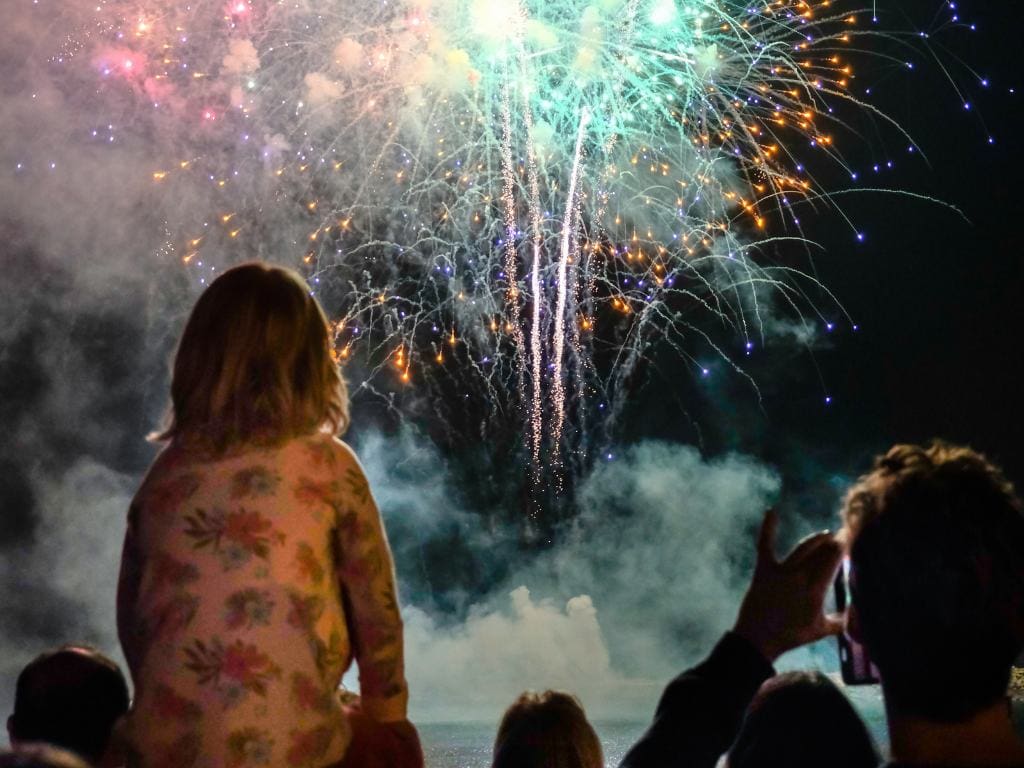
Barcelona’s Plaça d’Espanya is a popular spot to celebrate New Year’s Eve in Spain. The square hosts a big party with music, fireworks, and a light show at the Magic Fountain.
At midnight, the crowd joins together to eat the 12 grapes and toast to the new year. Be careful, or you’ll certainly get doused with cava as the crowd goes wild!
I should know, as it happened to me! I was drenched by young men spraying Cava and had to make a run for it!
As Barcelona is known for its nightlife, the party continues in the most popular clubs in the city with a fantastic atmosphere and ends with breakfast just after dawn.
3. Nochevieja Universitaria in Salamanca

Salamanca is home to one of the most unique New Year’s Eve celebrations in Spain.
On December 15, tens of thousands of revelers gather in the Plaza Mayor for a pre-New Year’s Eve party known as Nochevieja Universitaria.
Observed since 1999, Nochevieja Universitaria was concocted by university students as a way to celebrate the New Year with friends before returning home for the holidays.
Now, the city’s most anticipated party of the year boasts music, dancing, and fireworks. At midnight, grapes are replaced with sweets. After all, they’ll eat the grapes when celebrating New Year’s two weeks later!
Attending the festivities is a great way to experience Spanish culture with locals. (I actually studied abroad in Salamanca and can attest to the vibrancy of the city!)
4. Plaza del Obradoiro in Santiago de Compostela

Known at the final stop on the Camino de Santiago, Santiago de Compostela’s Plaza del Obradoiro hosts a lively New Year’s Eve celebration every year.
The square is filled with people who are eager to welcome the new year with fireworks and music!
At midnight, the Berenguela Tower chimes not 12, but 13 times! It’s said that the devil will have one hour to play his tricks, so watch out!
Find a place to stay in Santiago de Compostela within walking distance to the plaza!
5. Plaza del Ayuntamiento in Valencia

Valencia is known for it’s amazing fiestas and is a great place to celebrate New Year’s Eve in Spain.
The city hosts a big party in the Plaza del Ayuntamiento. For the celebration, the city hall’s balcony is transformed into a stage for DJs! Fireworks, music, and a light show complement the ringing of the bells and eating of the grapes.
The official NYE party lasts until 1:45 a.m., after which it may continue in bars and nightclubs throughout the city, which is located in the East part of Spain.
Practical Tips for Celebrating New Year’s Eve in Spain
If you plan on celebrating New Year’s Eve in Spain, here are some practical tips to help make your experience that much more memorable.
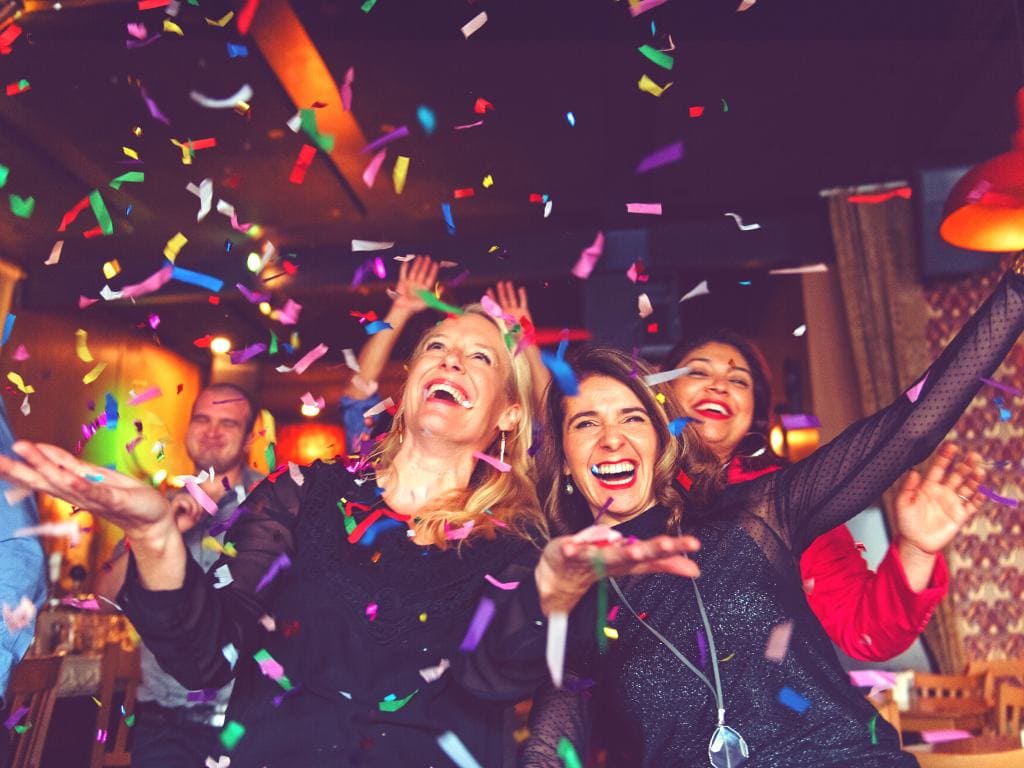
Find a Good Spot to Watch the Fireworks
Like in the United States and other countries around the world, watching fireworks displays is one of the highlights of celebrating New Year’s Eve in Spain.
Some of the most popular places for fireworks displays include Madrid’s Puerto del Sol, Barcelona’s Plaza España, Plaza de Ayuntamiento in Valencia, and Plaza del Carmen in Granada.
Make sure to arrive early to secure a good spot to watch the fireworks, and follow any official protocols to ensure the safety of all participants.
Dress Appropriately
The weather in Spain during New Year’s Eve can be quite chilly, especially if you plan on spending the night outdoors. Make sure to dress warmly and wear comfortable shoes if you plan on walking around to different celebrations.
If you didn’t pack appropriately, no worries! There are so many amazing clothing stores in Spain that you can pop into.
Plan Ahead for Transportation
It’s very important to plan ahead for transportation on NYE in Spain.
Public transportation will likely be limited on New Year’s Eve with a special holiday timetable. To explain, busses and trains may stop running earlier on the night of the 31st and start later on the 1st. Consult a proper timetable if you’re reliant on public transportation.
If you plan on taking a taxi, make sure to book one in advance by phone or App (Uber or Cabify) as they can be in high demand on New Year’s Eve.
If you plan on driving, be aware that there may be road closures and traffic congestion. We suggest you stay in the city center and avoid driving on December 31st.
Be Prepared for Crowds
New Year’s Eve celebrations in Spain can be quite crowded, especially in popular tourist destinations like the Puerta del Sol in Madrid.
Prepar yourself for large crowds, and plan accordingly. For example, consider arriving early to secure a good spot, and be patient when navigating through crowds.
Book Events in Advance
Hotels, restaurants, bars, and clubs often organize special New Year’s Eve celebrations to take advantage of the bump in revenue. These events may include dinner, an open bar, party favors, grapes, dancing til dawn, and/or other types of entertainment.
If you decide to go for one of these, book your table, or buy tickets beforehand. Don’t expect to get in just anywhere, especially in larger cities like Madrid and Barcelona.
You can expect to pay an cover fee to get into special parties, too.
Where to Stay for New Year’s Eve in Spain
If you’re heading to Spain for New Year’s, you’ll need a place to stay. In this section, we’ll give some practical travel tips for accommodations during the New Year in Spain in addition to some fabulous hotel recs for NYE in Spain!
Tips for Booking the Best NYE Accommodations
Stay in the Center – If there was ever an occasion to stay in the city center for, it would be for New Year’s in Spain. Avoid taking any type of transportation during the celebration by staying right downtown where all the action is.
Plus, you can easily run up to your room for bathroom breaks, rest, or snacks if you’re nearby!
Book in advance – With so many tourists heading to Spain for the holidays, it’s best to book early for the best selection!
Splurge – Prices will be at peak over the holidays, but this isn’t a time to budget. Get a place near the center to make your trip more enjoyable and safe.
What to Expect on New Year’s Day in Spain
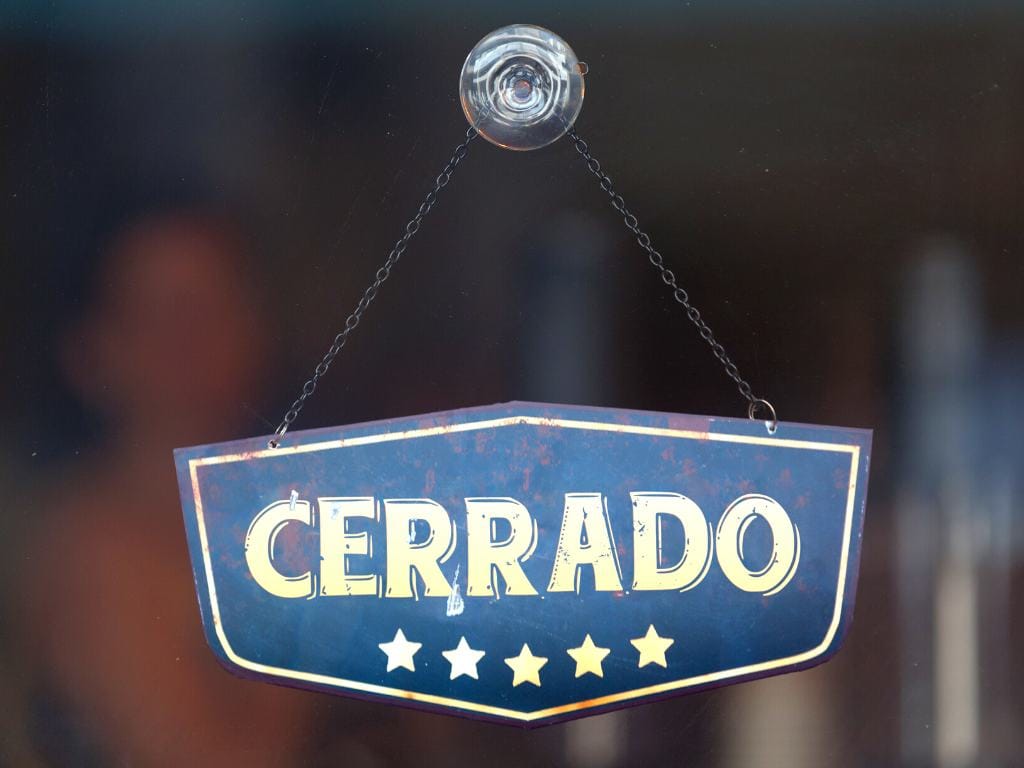
New Year’s Day, or Día de Año Nuevo in Spanish, is a national holiday in Spain.
Expect most businesses, including shops and restaurants, to be closed or have limited opening hours. In other words, plan ahead if you need to run errands or get groceries!
In larger cities like Madrid and Barcelona, some tourist attractions and museums may be open. Malls and larger stores, too! These cities know that tourists will be in town and citizens will be off work, both looking to spend money!
A good rule of thumb is to check the opening hours before going out.
As for Spaniards, many spend the day with family or friends. It’s common to enjoy a meal together, attend church services, or take part in other cultural activities.
New Year’s in Spain FAQ’s
How do they celebrate New Year’s Eve in Spain?
In Spain, New Year’s Eve, known as “Nochevieja,” is celebrated with lively gatherings of family and friends. Traditionally, Spanish people eat 12 grapes at the stroke of midnight, one for each chime of the clock, to usher in good luck for each month of the upcoming year. Fireworks displays, parties, and raucous festivities in public squares are also expected when ringing in the New Year in Spain.
What are some traditional Spanish New Year’s Eve foods?
In Spain, it’s customary to eat 12 grapes at midnight on New Year’s Eve, one for each stroke of the clock. Other traditional foods include dishes like roasts or garlicky shrimp accompanied by a traditional charcuterie board, roasted veggies, cold salads, and red cabbage with pine nuts. Sweets include Spanish nougat, turrón, or the traditional festive sweets of each region.
What is New Year’s Eve called in Spain?
New Year’s Eve is called “Nochevieja” in Spanish, which literally translates to “old night.” It’s a time for family gatherings, traditions to bring luck in the new year, lots of food and spakling wine, and celebrations that last well into the wee hours of the morning.
What is New Year’s Day called in Spain?
New Year’s Day is called “Día de Año Nuevo” in Spanish. Many families and friends spend time together on this day, and tourists should expect Sunday hours at most shops, restaurants, and tourist attractions.
Is Madrid or Barcelona better for New Year’s?
Both Madrid and Barcelona are excellent places to celebrate New Year’s Eve in Spain. Madrid’s Puerta del Sol is “kilometer zero” for NYE in Spain. It’s square is famous for its countdown and ringing of the bells at midnight called “Las Campanadas.” The celebrations here are broadcast all over Spain. Barcelona’s Plaça d’Espanya hosts a similar celebration full of music, fireworks, a lightshow, and lots of good cheer. It really comes down to personal preference and which city’s atmosphere appeals to you more.
What color is popular to wear on New Year’s Eve in Spain?
In Spain, it is traditional to wear red underwear on New Year’s Eve for good luck in the love department during the coming year.
What is “New Year’s Eve in August?”
“New Year’s Eve in August” is a popular celebration in the town of Bérchules, located in the province of Granada in Spain. The event, first held in 1994, was intended to help businesses recoup their losses after a power outtage ruined their New Year’s Eve celebrations in 1993. Today, the event is going strong with traditional New Year’s Eve celebrations, complete with fireworks, grape-eating, and partying until dawn.
How long do the New Year celebrations last?
New Years celebrations in Spain last until the morning, with many people dispersing from the main square within an hour or so before heading off to continue the party at various clubs or bars.
Is New Year’s Eve in Spain Worth it?
Having spent New Year’s Eve in Spain, I can confidently say this: Yes, New Year’s Eve in Spain is worth it!
NYE is a time for celebration in Spain—something Spaniards know how to do like no other!
But it’s also more than that. New Year’s is a day to look towards the future, closing one chapter and opening a new one. In our opinion, there’s no better way to start that book than to join in on the many New Year’s Eve traditions in Spain!
Blogs on Visiting Spain During the Holidays
Going to Spain during the holidays? Here are some related articles. ⤵
